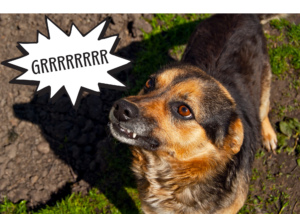
Imagine a friend is poking fun at you and you’re both laughing but then they start taking it too far. It started out funny, but now you’re not loving it anymore. “Okay, hey, that’s enough,” you might say. Your reaction is a natural warning signal. For dogs, that natural signal is a growl, and it’s every bit as valuable as our human expressions of discomfort.
Growling is not a sign of a bad dog; it’s part of their language. It’s how our dogs say, “I’m not okay with this right now.” It could be a stranger coming onto their territory, or guarding a high-value toy, or feeling overwhelmed at the dog park. This vocal cue is their way of communicating stress, boundaries, or potential aggression – without resorting to more drastic measures (like an air snap or an actual bite).
When we scold a dog for growling, we’re essentially telling them to silence their feelings. It’s like taking the batteries out of a smoke alarm because we don’t like the sound. Without growling, we miss critical communication about our dog’s emotional state, which can lead to “surprise” bites that we didn’t see coming.
Instead of jumping right to punishment, let’s listen. A growl is a chance to back up, assess the situation, and address the root cause of our dog’s discomfort. It’s an opportunity for a teachable moment, to guide our dogs through their anxieties and show them there’s nothing to fear.
It’s not easy because growling can feel so intimidating and upsetting at first. But try to see the growl as an honest conversation starter. By understanding and respecting this canine signal, we reinforce trust and safety for everyone involved.
So next time you hear a growl, thank your dog for speaking up. They’re trusting you to respond with compassion and curiosity. Doing so will strengthen your bond and give you a chance to determine what’s wrong. Since growling can be related to aggression, seek the help of a professional certified trainer. You can find out what’s bothering your dog and get things back on track, for both of you.






 Phone:
Phone: